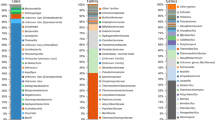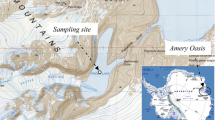Abstract
DNA was extracted from water and sediment samples taken from soda lakes of the Kenyan-Tanzanian Rift Valley. DNA was also extracted from microbial enrichment cultures of sediment samples. 16S rRNA genes were amplified by the polymerase chain reaction and microbial diversity was studied using denaturing gradient gel electrophoresis (DGGE) of 16S rDNA amplicons. Cloning and sequencing of single DGGE bands showed that they usually contained mixed amplicons. Several of the amplicon sequences had high identities, up to 99%, with 16S rRNA genes of organisms previously isolated from soda lakes, while others were only distantly related, with identities as low as 82%. Phylogenetic analysis of the sequenced amplicons indicated that sequences were related to the haloarchaeal, Bacillus/Clostridium, Rhodobacterium/Thioalcalovibrio/ Methylobacter, and Cytophaga/Flavobacterium/Bacteroides (CFB) groups and the enterobacteria/Aeromonas/Vibrio part of the γ3 subdivision of the Proteobacteria.




Similar content being viewed by others
References
Chen WP, Kuo TT (1993) A simple and rapid method for the preparation of gram-negative bacterial genomic DNA. Nucleic Acids Res 21:2260–2260
Don RH, Cox PT, Wainwright BJ, Baker K, Mattick JS (1991) Touchdown PCR to circumvent spurious priming during gene amplification. Nucleic Acids Res 19:4008–4008
Duckworth AW, Grant WD, Jones BE, van Steenburgen R (1996) Phylogenetic diversity of soda lake alkaliphiles. FEMS Microbiol Ecol 9:181–191
Grant WD, Tindall BJ (1980) Isolation of alkaliphilic bacteria. In: Herbert RA, Codd GA (eds) Microbial growth and survival in extremes of environment. Academic Press, London, pp 27–36
Grant S, Grant WD, Jones BE, Kato C, Li L (1999) Novel archaeal phylotypes from an East African alkaline saltern. Extremophiles 3:139–145
Jones BE, Grant WD, Collins NC, Mwatha WE (1994) Alkaliphiles: diversity and identification. In: Priest FG, Ramos-Cormenzana A, Tindall BJ (eds) Bacterial diversity and systematics. Plenum Press, New York, pp 195–230
Jones BE, Grant WD, Duckworth AW, Owenson GG (1998) Microbial diversity of soda lakes. Extremophiles 2:191–200
Jukes TH, Cantor CR (1969) Evolution of protein molecules. In: Munro HN (ed) Mammalian protein metabolism. Academic Press, New York, pp 21–132
Kevbrin VV, Zhilina TN, Rainey FA, Zavarzin GA (1998) Tindallia magadii gen. nov., sp. nov.: an alkaliphilic anaerobic ammonifier from soda lake deposits. Curr Microbiol 37:94–100
Lindstrom ES (1998) Bacterioplankton community composition in a boreal forest lake. FEMS Microbiol Ecol 27:163–174
Melack JM, Kilham P (1974) Photosynthetic rates of phytoplankton in tropical African soda lakes. Hydrobiologia 81:71–85
Milford AD, Achenback LA, Jung DO, Madigan MT (2000) Rhodobaca bogoriensis gen. nov. and sp. nov., an alkaliphilic purple nonsulfur bacterium from African Rift Valley soda lakes. Arch Microbiol 174:18–27
Muyzer G, de Waal EC, Uitterlinden AG (1993) Profiling of complex microbial populations by denaturing gradient gel electrophoresis analysis of polymerase chain reaction-amplified gene coding for 16S rRNA. Appl Environ Microbiol 59:695–700
Pikuta EV, Lysenko AM, Zhilina TN (1998) Distribution of Desulfonatronovibrio hydrogenovorans in soda lakes of Tuva. Microbiology 66:216–221
Pitcher DG, Saunders NA, Owen RJ (1989) Rapid extraction of bacterial genomic DNA with guanidium thiocyanate. Lett Appl Microbiol 8:151–156
Rees HC (2002) Environmental gene screening. PhD thesis, University of Leicester, Leicester, UK
Sommer R, Tautz D (1989) Minimal homology requirements for PCR primers. Nucleic Acids Res 17:6749
Sorokin DY, Jones BE, Kuenen JG (2000) An obligate methylotrophic, methane-oxidizing Methylomicrobium species from a highly alkaline environment. Extremophiles 4:145–155
Sorokin DY, Lysenko AM, Mityushina LL, Tourova TP, Jones BE, Rainey FA, Robertson LA, Kuenen GJ (2001a) Thioalkalimicrobium aerophilum gen. nov., sp nov and Thioalkalimicrobium sibericum sp nov., and Thioalkalivibrio versutus gen. nov., sp nov., Thioalkalivibrio nitratis sp nov and Thioalkalivibrio denitrificans sp nov., novel obligately alkaliphilic and obligately chemolithoautotrophic sulfur- oxidizing bacteria from soda lakes. Intl J Syst Evol Microbiol 51:565–580
Sorokin DY, Kuenen GJ, Jetten MSM (2001b) Denitrification at extremely high pH values by the alkaliphilic, obligately chemolithoautotrophic, sulphur-oxidising bacterium Thioalkalivibrio denitrificans strain ALJD. Arch Microbiol 175:94–101
Sorokin DY, Gorlenko VM, Tourova TP, Tsapin A, Nealson KH, Kuenen GJ (2002) Thioalkalimicrobium cyclicum sp nov and Thioalkalivibrio jannaschii sp nov., novel species of haloalkaliphilic, obligately chemolithoautotrophic sulfur-oxidizing bacteria from hypersaline alkaline Mono Lake (California). Int J Syst Evol Microbiol 52:913–920
Stackebrandt E, Gobel UB (1994) Taxonomic note: a place for DNA-DNA reassociation and 16SrRNA sequence analysis in the present species definition in bacteriology. Int J Syst Bacteriol 44:846–849
Svetlitshnyi V, Rainey F, Weigel J (1996) Thermosyntropha lipolytica gen. nov., sp. nov., a lypolytic, anaerobic, alkalitolerant, thermophilic bacterium utilising short- and long-chain fatty acids in syntrophic coculture with a methanogenic archaeum. Int J Syst Bacteriol 46:1131–1137
Tindall BJ, Ross HNM, Grant WD (1984) Natronobacterium gen. nov. and Natronococcus gen. nov., two new genera of haloalkaliphilic archaebacteria. Syst Appl Microbiol 5:41–57
Van de Peer Y, De Wachter R (1993) TREECON: A software package for the construction and drawing of evolutionary trees. Comput Appl Biosci 9:177–182
Zavarzin GA, Zhilina TN, Kevbrin VV (1999) The alkaliphilic microbial community and its functional diversity. Microbiology 68:503–521
Zhilina TN, Zavarzin GA (1994) Alkaliphilic anaerobic community at Ph-10. Curr Microbiol 29:109–112
Zhilina TN, Zavarzin GA, Rainey FA, Pikuta EN, Osipov GA, Kostrikina NA (1997) Desulfonatronovibrio hydyogenovorans gen nov, sp nov, an alkaliphilic, sulfate-reducing bacterium. Int J Syst Bacteriol 47:144–149
Acknowledgements
This study was supported by a committee studentship from the Biotechnology and Biological Sciences Research Council to H.R.
Author information
Authors and Affiliations
Corresponding author
Additional information
Communicated by K. Horikoshi
Rights and permissions
About this article
Cite this article
Rees, H.C., Grant, W.D., Jones, B.E. et al. Diversity of Kenyan soda lake alkaliphiles assessed by molecular methods. Extremophiles 8, 63–71 (2004). https://doi.org/10.1007/s00792-003-0361-4
Received:
Accepted:
Published:
Issue Date:
DOI: https://doi.org/10.1007/s00792-003-0361-4




